Imagination Announces PowerVR Series7 GPUs - Series7XT & Series7XE
by Ryan Smith on November 10, 2014 8:50 AM EST- Posted in
- GPUs
- Mobile
- Imagination Technologies
- PowerVR
- PowerVR Series7
Series7XT In Detail
Now that we’ve had a chance to look at the common Series7 architecture, let’s take a look at the features and properties of Series7XT in particular.
Series7XT will be offered with 2 optional feature additions. The first is the aforementioned FP64 ALU, which is being offered as part of what Imagination is calling the HPC Feature Pack. As FP64 operations are not necessary for graphics work (and often even FP16 will do), the FP64 functionality is being offered to customers who want to build HPC hardware out of Series7XT. PowerVR hardware has up until now not been a competitor in the HPC space, so this marks a significant turning point for Imagination and would have them challenging frontrunner NVIDIA in this space. Also of note here, as the base 7XT configuration only supports OpenCL 1.2 Embedded Profile, the HPC pack upgrades 7XT’s OpenCL capabilities to 1.2 Full Profile.
Meanwhile the other optional feature pack for Series7XT is the Direct3D 11 pack, which is primarily geared towards customers who would be building Windows Phone and Windows RT devices. Imagination made Direct3D 11 an optional feature on 6XT, and is doing the same on 7XT. In the case of 6XT the D3D option would have added the necessary tessellation capabilities that are now default on 7XT, so for 7XT this is likely more about D3D features such as S3TC that require additional licensing.
Moving on, for as much as Imagination’s various enhancements ultimately improve performance, really it’s power efficiency that’s driving most of Imagination’s performance gains, and 7XT in turn is designed to further improve on Imagination’s power efficiency. Unfortunately Imagination isn’t throwing out any numbers here – just that 7XT can offer similar performance as 6XT for less power – but on the subject of power efficiency they have documented their efforts to deal with throttling.
To be clear here this is a matter ultimately in the hands of SoC integrators and is not something Imagination can directly control, but as a supplier they can offer advice and suggestions to their customers to improve the experience. Short of making PowerVR GPUs low power in the first place (and this is something everyone in this space tries to do), the next best thing they can do is to encourage customers to be mindful of throttling and to discourage designing their clockspeed governors to be bursty. While the “hurry up and go to sleep” motto makes a lot of sense for CPUs, it makes less sense for GPUs due to the fact that most workloads are sustained. By providing good real-time power usage data to the OS and by discouraging high maximum clockspeeds that lead to burst-and-throttle behavior from governors, for Series7 Imagination is at least trying to ensure that throttling is minimized.
Finally, Imagination has outlined the different configurations that Series7XT will be available in. Starting in 2 cluster configurations, 7XT scales up to 16 cluster configurations, or twice as large as 6XT. 2-4 cluster configurations are expected to be used in phones and TVs, meanwhile 6-8 cluster configurations are expected to be used in tablets, automotive, and ultrabooks. Finally the 16 cluster configuration would be targeted at non-traditional spaces for PowerVR products, such as full notebooks, dedicated (set-top) gaming devices, and servers. With a hefty 512 FP32 ALUs Imagination expects that the 16 cluster configuration should rival lower-end discrete GPUs, which would certainly be the competition for the device categories that Imagination is chasing.
Series7XE In Detail
Moving on, at the other end of the spectrum we have the Series7XE GPUs. These products are the successors to the Series6XE GPUs, and like their predecessors are focused on a narrower feature set for low cost devices, with an emphasis on area efficiency over power efficiency.
Of the Series7 features we’ve covered so far, Series7XE gains access to virtually all of those features. However a larger number of those features are optional and are not in the base configuration. Of note, all of the general enhancements for the frontends and the USC are carried over for the base configuration. However the tessellation block (and hence AEP support) is optional.
As a result 7XE has 4 optional feature packs to build on top of its base OpenGL ES 3.1 functionality. The AEP adds the tessellator and other AEP-centric functionality from 7XT that isn’t in 7XE’s default configuration. Meanwhile the Compression Pack segregates certain compression features from 7XE so that they’re only included in designs that need them (since SoC manufacturers may want to use 3rd party compression technology). HEVC and 10-bit YUV support is also optional for 7XE, and finally the virtualization features we discussed earlier are optional as well.
Since 7XT is targeted at 2 cluster and above configurations, 7XE is designed to cover the 1 and ½ cluster configurations. This results in 2 configurations, the GE7800 which implements a full cluster, and the GE7400 which implements a half-cluster. With the 1 cluster configuration targeted at low-end phones and TVs, the half-cluster configuration will be in the cheapest and simplest devices, along with being a candidate for high-end wearable devices.
Imagination says that at the low clockspeeds they’re envisioning for 7XE wearables, the full load power for the GPU would be under 1W, with low/idle power consumption of course being much lower yet. Any kind of power consumption approaching 1W definitely also approaches a “high-end” niche for wearables, but none the less it is viable if for any reason someone needed to build a wearable device that could handle OpenGL ES 3.1 graphics.


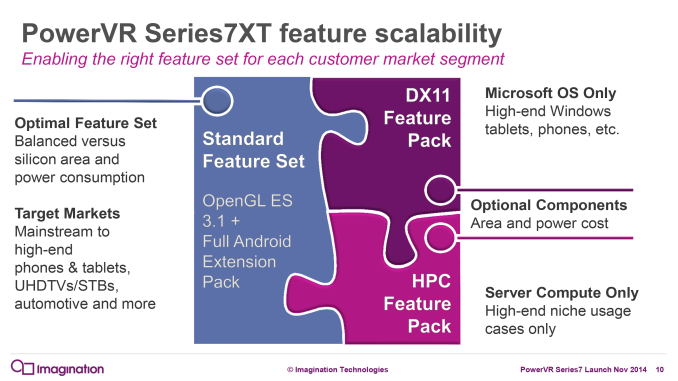
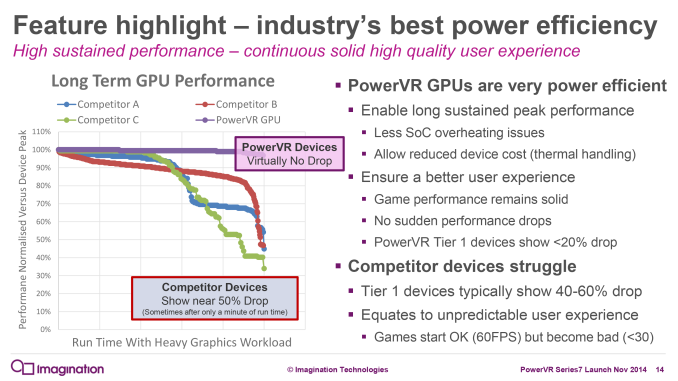
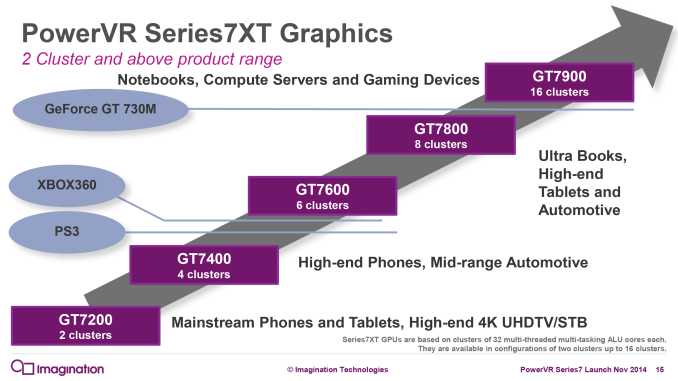
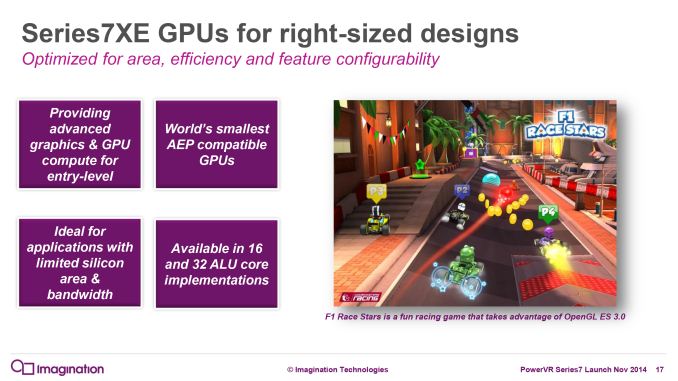
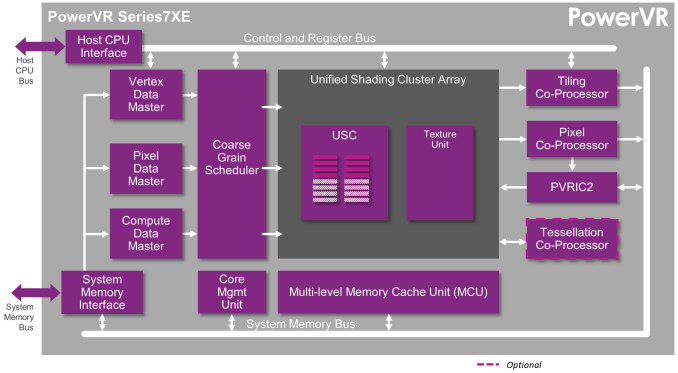
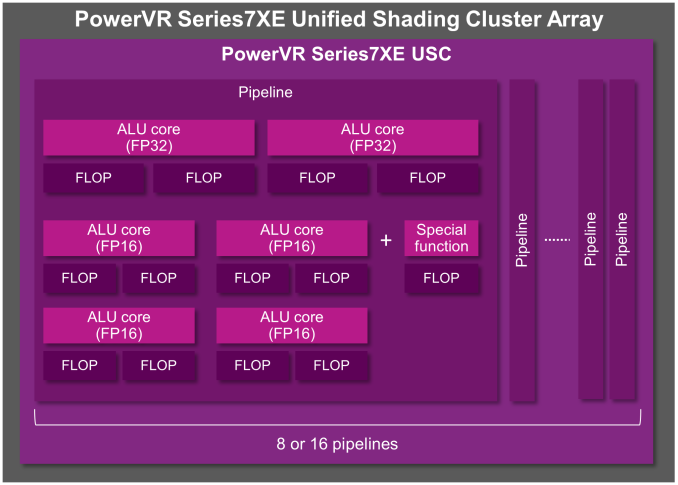
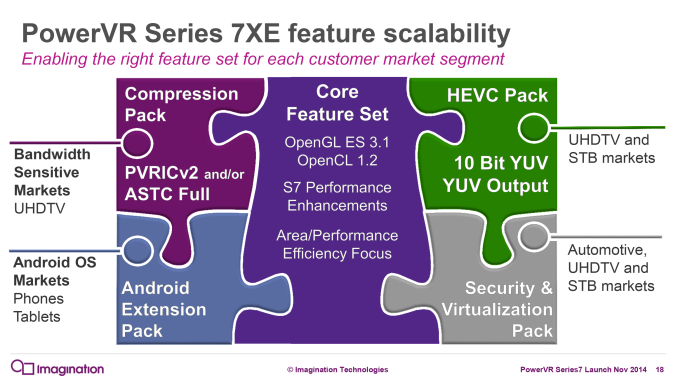









49 Comments
View All Comments
darkich - Monday, November 10, 2014 - link
Actually, there is no comparison, considering that HD 5000 sucks 3 times more power.In an unrestricted environment, this should absolutely demolish Intel GPU, even the new architecture brought with the Core M.
But the Maxwell Tegra GPU looks even worse for Intel.
darkich - Monday, November 10, 2014 - link
It really will be interesting to see what happens to Core M if Intel decides to continue using PowerVR in Atom lineup.. Intel's own integrated graphics are no match at all in a given power envelopeAlexvrb - Monday, November 10, 2014 - link
Intel decides which design to implement... if they want to intentionally use fewer clusters, they can. If they want to limit max GPU clocks and willfully deploy a gimped IMC to starve it for bandwidth, they can. They'll make sure Atom still slots in below higher-end Core solutions.What would be more interesting is if they were to implement a full-blown Series 7 setup in some of their higher-end chips. 16 clusters with aggressive clocks would definitely be interesting. But it'll never happen.
darkich - Tuesday, November 11, 2014 - link
But that's the thing, the sole purpose of Atom chips is to compete on the most competitive chip environment there is - battling ARM in an effort to get some ground in mobile.If Intel intentionally cripples Atom just to stay bellow the Core M, then it can continue to watch ARM chips reigning supreme.
ET - Tuesday, November 11, 2014 - link
I'd really love to see Intel using a high performance core for tablet CPU's. I know Intel plans to improve on Bay Trail's GPU performance, but I think we need something really good. (Then again, using PVR might result in driver related problem.)przemo_li - Tuesday, November 11, 2014 - link
They aren't.They have their own tech, and they are sticking too it.
(Hint, they use FLOSS drivers for Android, you can check code repos to see whats coming).
They still have some good arguments for themselfs:
1) They are still kings of node process.
2) They have open source gpu drivers. (Game devs do not need to sit in front of black box, guessing why their code is so slow!)
3) They still have huge cash stockpile.
I'm not saying that 1-3 mean that they will win lots of designs, but they can wait for their turn.
djgandy - Monday, November 17, 2014 - link
2) Yeah they know why its slow. Because its running on an Intel GPU.przemo_li - Tuesday, November 11, 2014 - link
Intel GPU have (in iris configs) 500 mb of on die cache.Can't do on smarphone.
TheinsanegamerN - Tuesday, November 11, 2014 - link
First of all, iris pro has 128MB of cache, not 500MB. Second, you are comparing a chip that pulls ~55 watts to a gpu used in sub 5 watt chips. not even a close comparison. Third, if this powervr 7 can hit 300 GFLOP, then it will already be a third of the way to meeting the fastest version of iris pro (832 GFLOP), and heck, the A8X already is a fourth of the way there with 231 GFLOP. Fourth, it;s called a smartphone, not a smarphone.przemo_li - Wednesday, November 12, 2014 - link
Correct 128mb.But still that mean unachievable performance.
(Not saying that Intel can actually at their 22nm process, squeeze that into smartphones.)